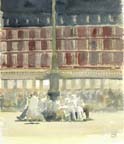
Spain & France 2008
Michael Kluckner

Return to main travel page Return to home page
| A
long-anticipated return to Spain, where I'd last travelled
extensively in 1971, and an opportunity for us to explore
unfamiliar parts of Périgord, Dordogne, Normandy and Brétagne in
France. Christine and I spent September en
route, with a final four days in Paris before starting
the long trip back to Australia. We travelled with just a carry-on bag each and spent about two-thirds of the time "outside the bubble" on local buses, trains and the hotels we happened upon, the rest "inside the bubble" of a rented car/rented cottage where it's easy to set up and paint watercolours while being somewhat separated from the hoi polloi. I had an 8 1/4 x 5 inch Moleskine sketchbook, ... 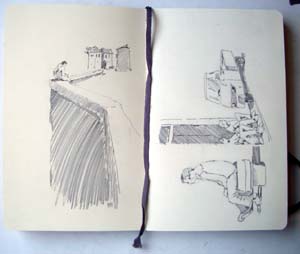 ...Bic mechanical pencils (HB
leads) and eraser, plus 2 bound signatures of Arches
watercolour paper, giving me about 28 pages measuring 11 x 7
1/2 inches. At the last minute I didn't take a fully-bound
sketchbook like the one illustrated on my travel
page as I wanted my luggage to be under about 7.5 kg.
I'm getting too old to carry much.... The paintbox was the
same as always -- the one on the travel page.
|
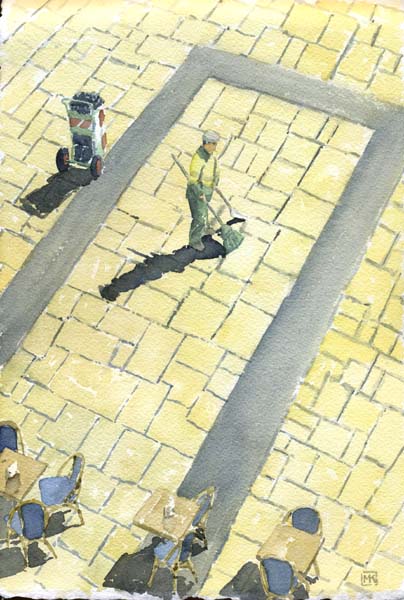 The Filter-Tip Hunter, Sarlat-la-Canéda, 11 x 7 3/8 inches |
|
"Outside
the Bubble" pencil sketches
Our travels by bus and train, and the days wandering around in the cities that were our destinations, gave me a lot of time to draw quickly and surreptitiously in pencil, mainly people --just catching, for example, the head and body angles of bored travellers in bus stations or chess players in Paris's Jardin de Luxembourg. Watercolours are great for landscape, but there's some set-up, the paper should be wet and so on, making them difficult to start while on foot in a city. And, pencil sketching allows you to get much closer to the "hither and yawn" reality of a journey: the waiting, the hanging-out in cafes and bars, the people-watching that's an essential part of European culture. In addition to other ordinary travellers, I drew the ubiquitous street sweepers of Spanish and French cities (like the one above, painted later), where a huge amount of tax money and effort goes into cleaning up after smokers, and made reference to the discarded filter tips that carpet every outdoor surface in some of the other images. But the cities are cleaner -- there are certainly fewer déchets de chien (dog turds) to slalom around on the sidewalks than there used to be.
|
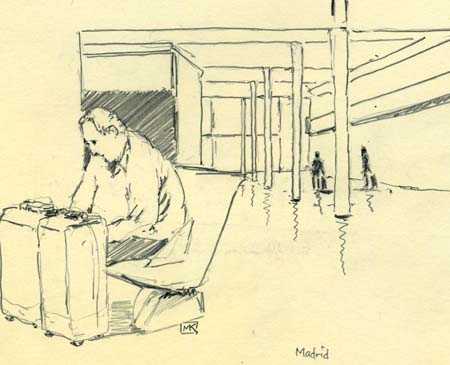
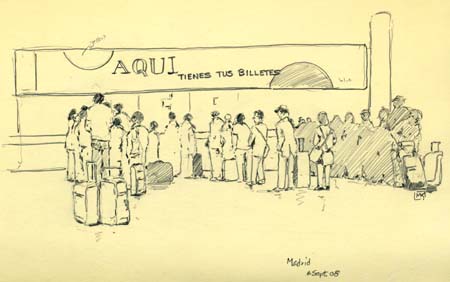

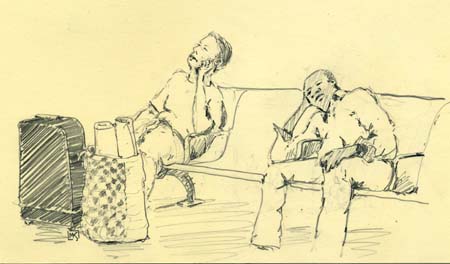
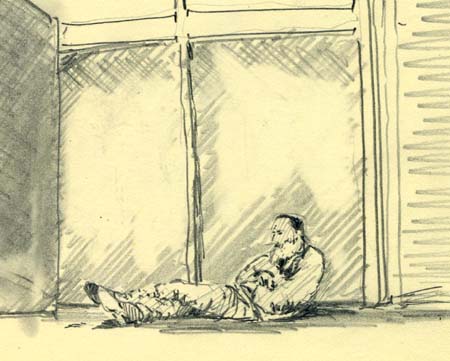
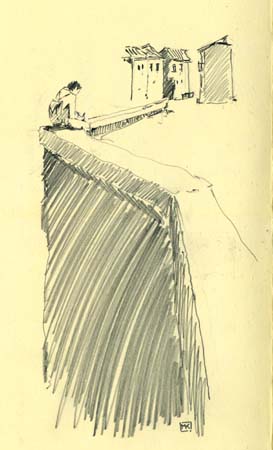
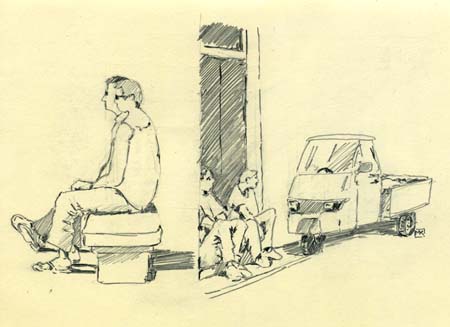
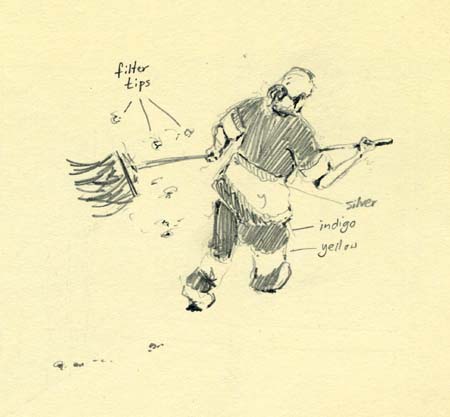
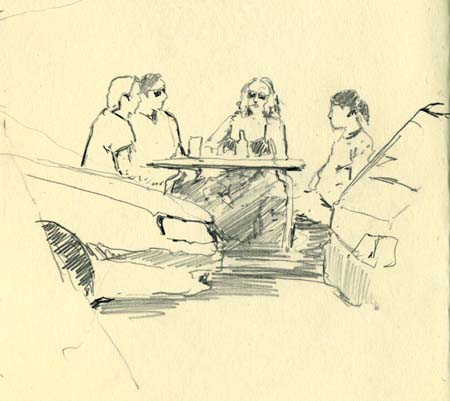

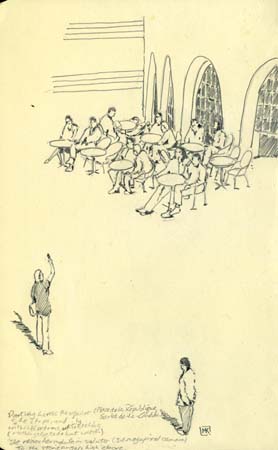
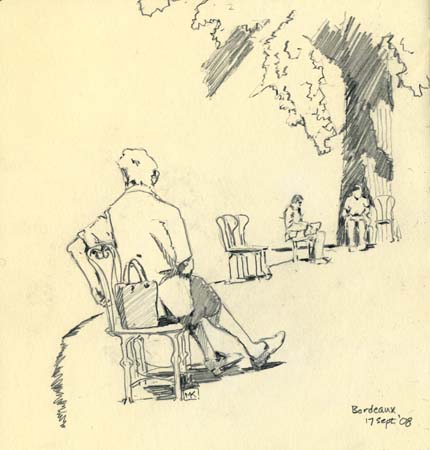
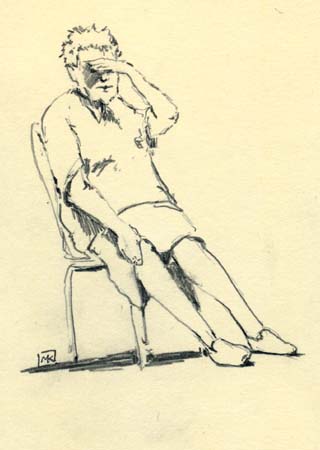

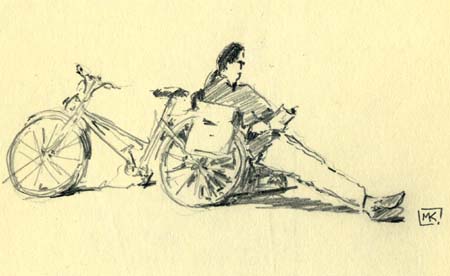
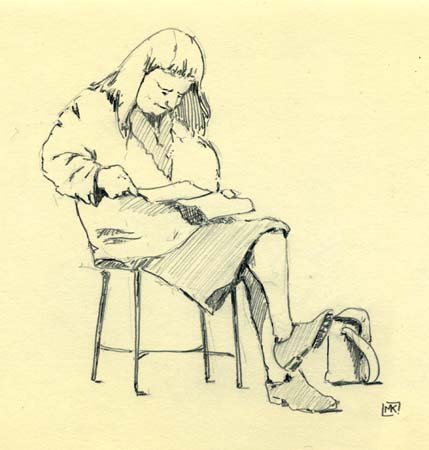
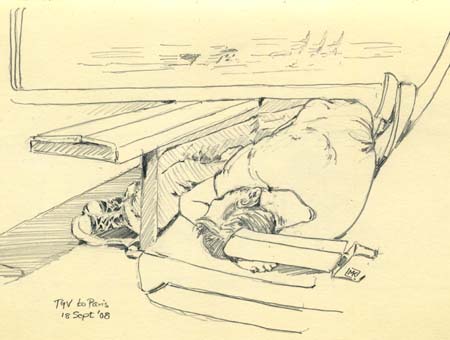
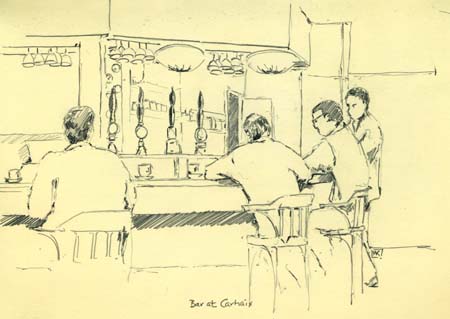
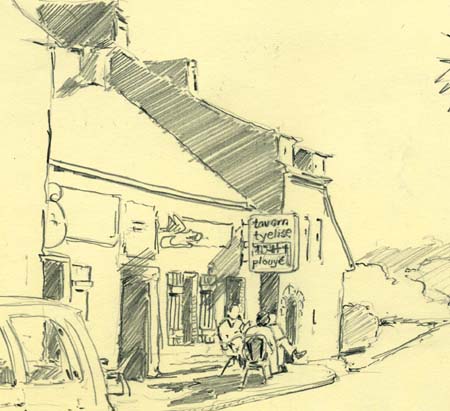

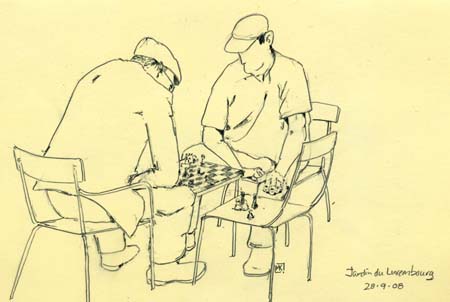
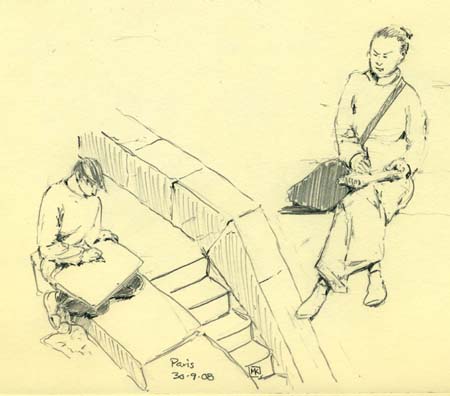
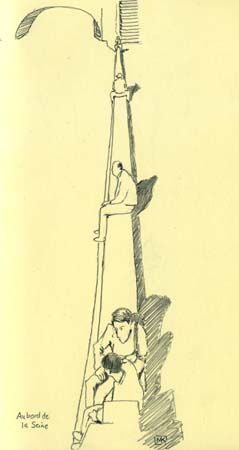
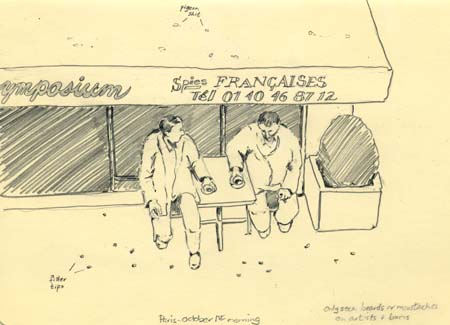
Watercolours
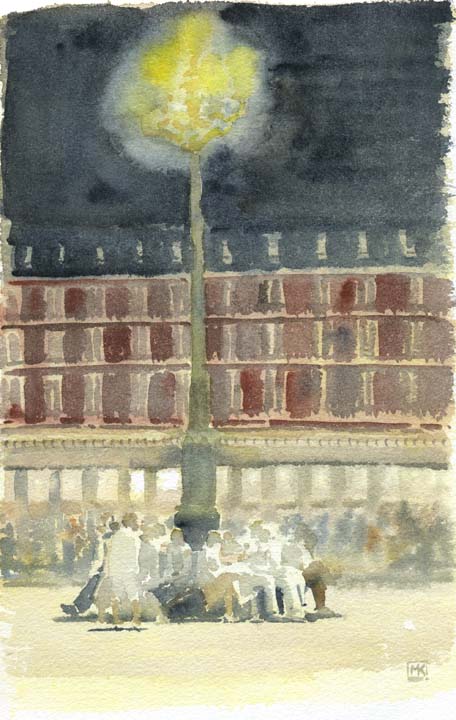 |
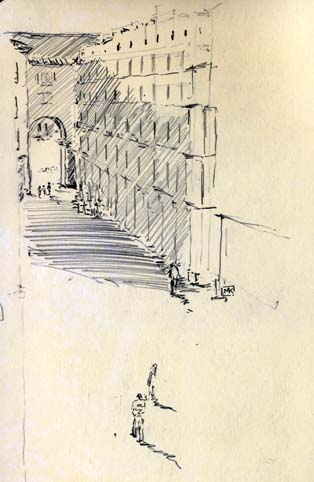 The Plaza Mayor in Madrid is
one of the great urban spaces anywhere.
Left: Crowds fill the square every evening, promenading, clustering together on the seats at the base of the lamps and eating and drinking in the cafes around the perimeter. (From a pencil sketch, painted later on soaking-wet paper.) Above: from our hotel room, looking along one of the streets that enters the Plaza Mayor through an arched portal. |

| Above:
the Alhambra, a view from the terrace of the Iglesia del
Salvador on the opposite side of the Rio Darro. An impossibly
magical place on a wooded hill above Granada, with the Sierra
Nevade as a backdrop. One of those places like Mont St. Michel
(below), but not Naples anymore, to "see before you die" as in
the cliché. Right: a pencil sketch from the Generalife, the summer garden-palace adjoining the Alhambra. In the watercolour above, the Generalife is the small brownish shape at the left edge of the spiky cypress trees. |
 |
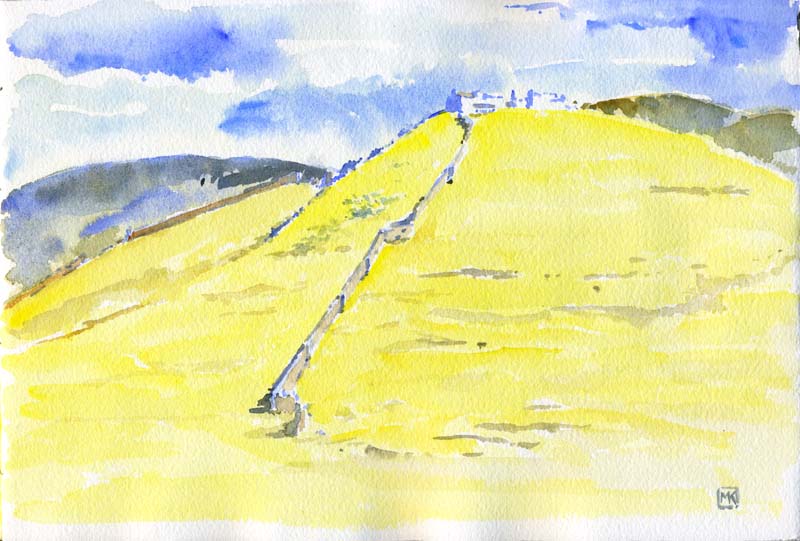
| An image capturing something of the wild sere landscape of Andalucia: an ermita on the outskirts of Granada. |
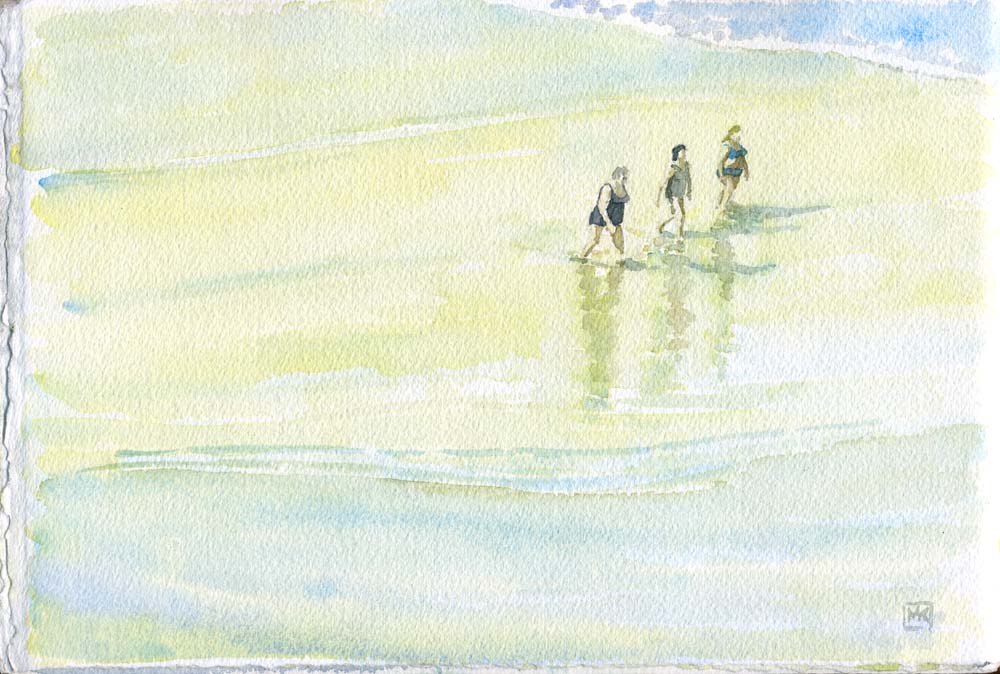
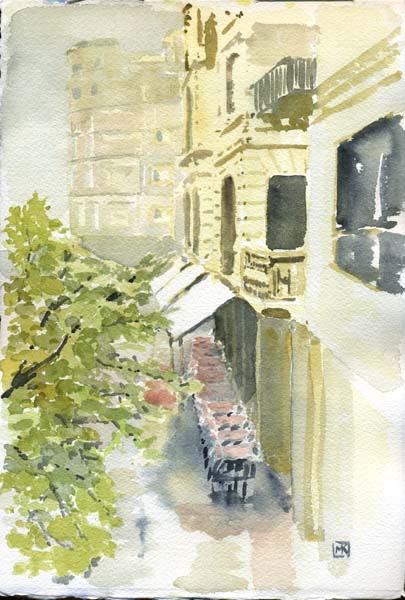 |
San Sebastian, aka
Donostia in the Basque language, the beautiful old city on the
Bay of Biscay just west of the French border. Left: from the window of our hotel room on the Boulevard del Alameda, the empty cafe tables of a rainy afternoon. Above: by the following morning the rain had stopped although the sky was still stormy, yet it was warm enough for bathers to walk in the incoming tide on the Playa de la Concha. |
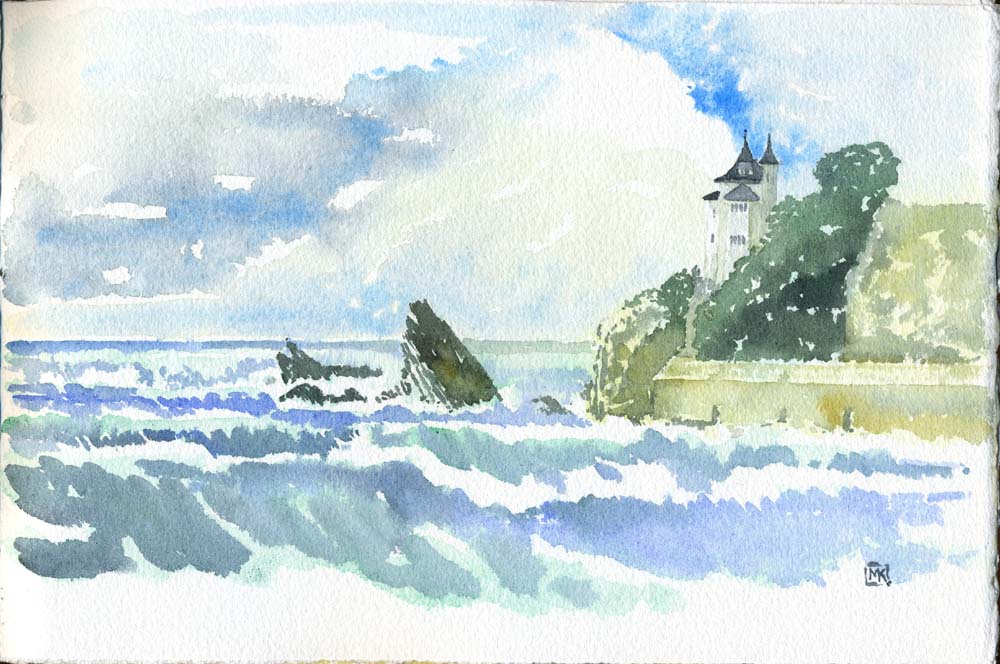
| Storms continued on the Bay of Biscay for a few days. We journeyed to Biarritz, the famous watering hole for the rich of a century ago, just to see if it retained any magic. It did.... Around the point from the main beach, a picturesque old villa commanded the headland. Sat on the wall and did a pencil sketch to paint from later. Our rental car windshield was misted with salt spray by the time we left. |
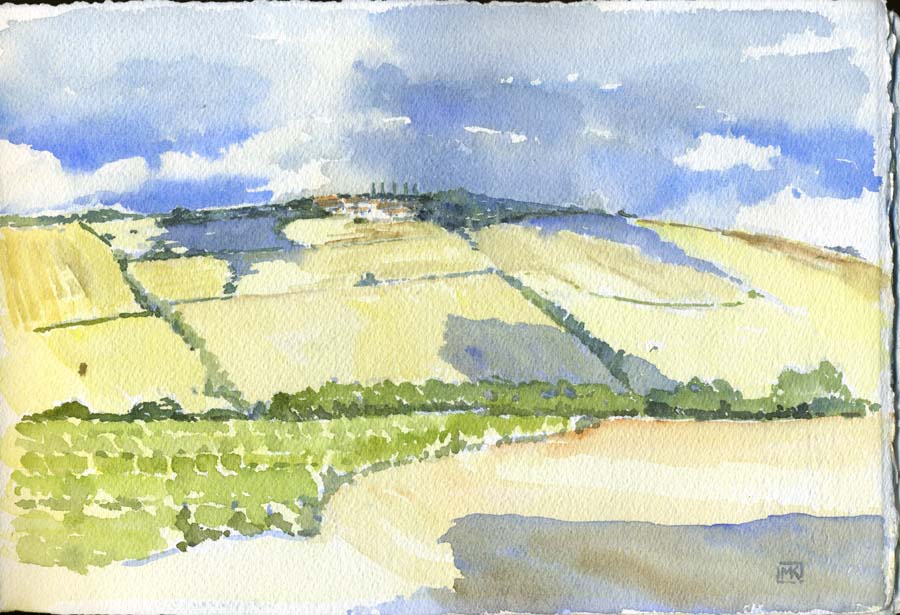
| A village on a hill near the town of Condom (yes, that's its name) south of the old city of Agen on the Garonne, prune plum orchards everywhere, a thunderstorm gathering itself in the northern sky .... |

Périgord landscape of sunflowers and corn north of
Villeneuve-sur-Lot
 |
Left:
From Bergerac (where Cyrano lived) the D660 runs east
through a splendid, picturesque landscape along the Dordogne
River, past cornfields and castles. So much corn, more than I
ever imagined was grown in France. We speculated whether it was
grown for goose-stuffing to make the region's speciality: paté
de fois gras. Below: Two views of the Dordogne River from a rocky outcropping, part of the hill on which the Château de Marqueyssac sits in a valley of châteaux southwest of Sarlat-la-Canéda. While Christine explored the château's garden of sculpted boxwood, I sat in the sun on a wall on the edge of the cliff and painted, blocking in both pictures just with the cobalt blue shadows, finishing them later. La douce France .... |
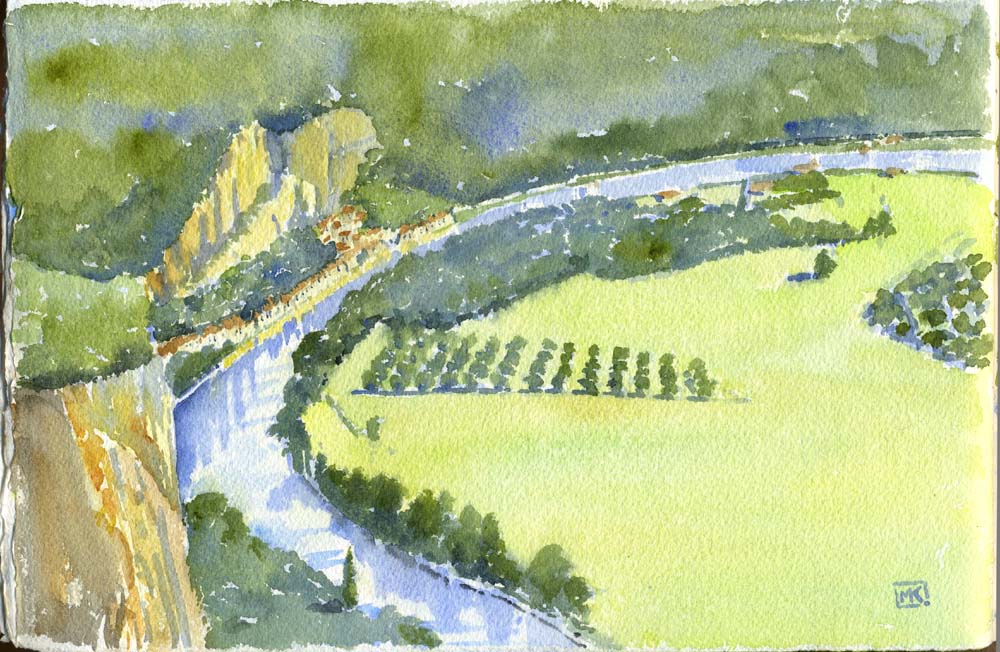
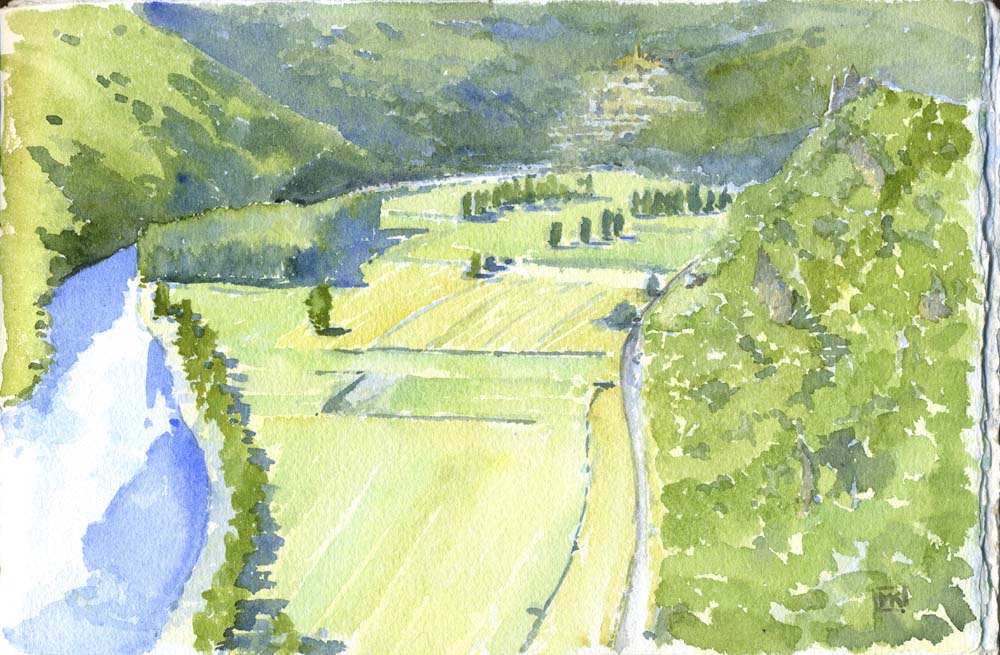
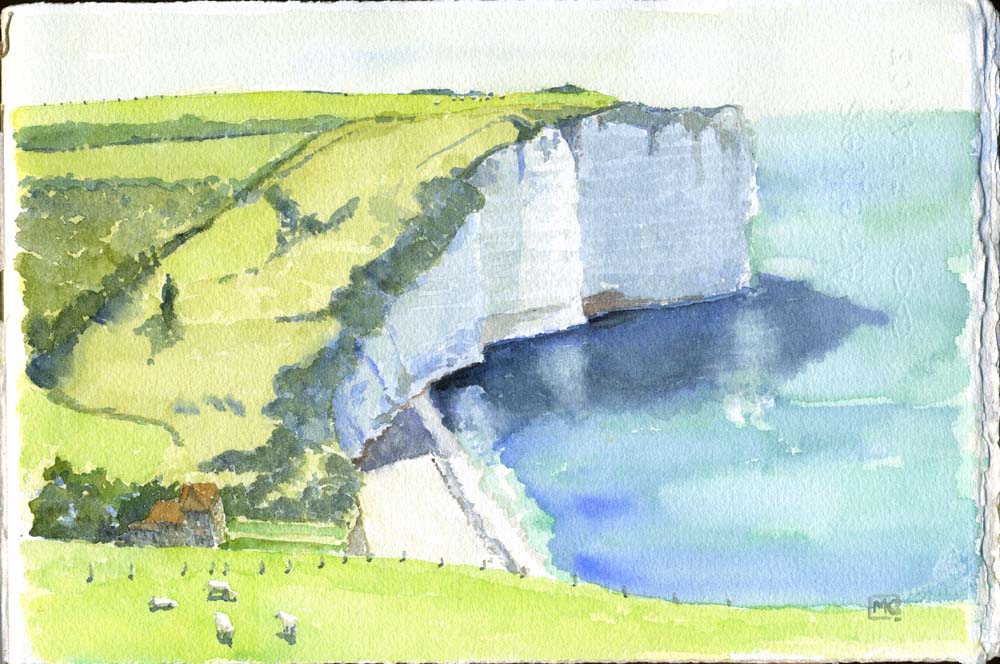
| A week later we were in Normandy, working our way south from the Dieppe area toward Etretat -- the famous set of pierced rocky monoliths extending into the English Channel that Monet, among others, painted. Came upon this view of beach and granite cliff near Vaucottes a few kilometres north of Etretat, where it was pleasant to sit in the grass and paint. Cars stopped while I painted and people jumped out eagerly with their cameras, but their dreams of the perfect shot were stymied by a large, tall mobile phone tower in the field directly below me more or less dead-centre in the scene. There are benefits to being a painter sometimes .... Etretat itself was exceptionally touristy -- dramatic but groomed -- and I painted nothing there. |
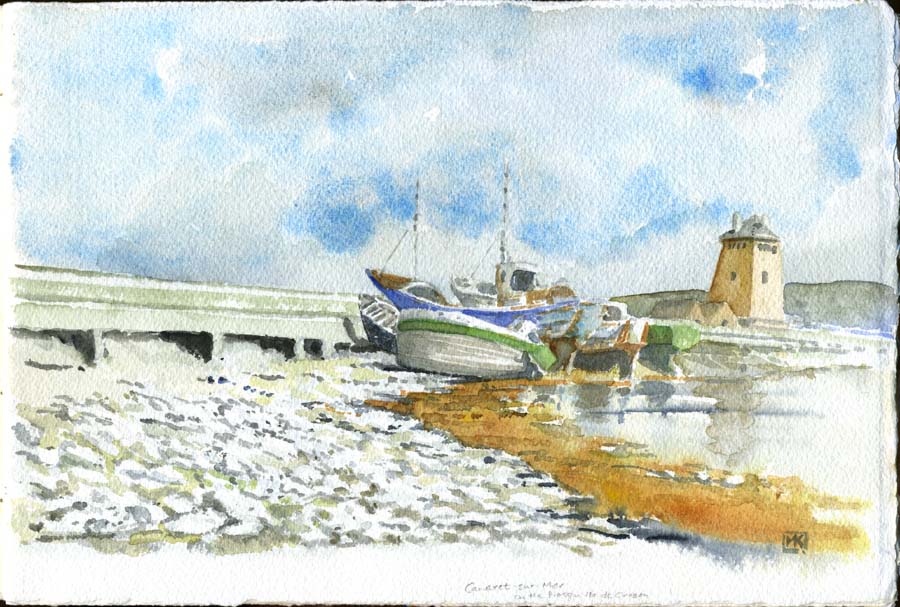
| In Brétagne, out in
the extreme west in the Finistère region, dramatic rocky
promontories shelter picturesque harbours. Above: old fishboats on the shore inside the breakwater at Camaret-sur-Mer. Right: the Point de Pen-Hir is the most westerly spot on the Presqu'ile de Crozon, and as such commands the entry to the strategic harbour at Brest. It was laced with tunnels and fortifications, originally 19th century but augmented by German ones from WWII. I drew the people walking the ridges out to the edge, where rugged granite cliffs spilled down to the sea hundreds of metres below. |
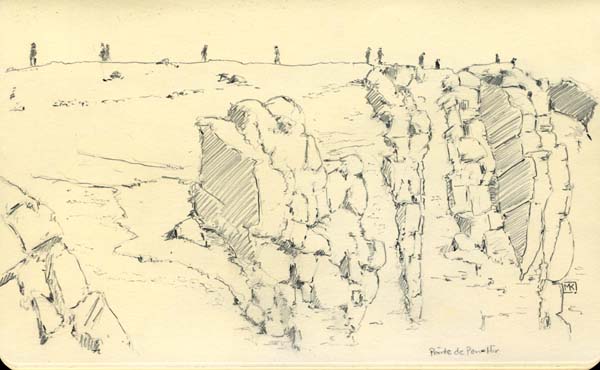 |
| Below are four daubs of Mont St. Michel, the fabulous monastery on a granite cone rising 80 metres from a bay on the English Channel, as ineffably wonderful as the Parthenon or the Istanbul mosques or Notre Dame de Paris. I cycled by it when I was 20 and impecunious, so didn't stop, finally getting back to it only now... Signs celebrated its recent 1300th anniversary: it dates from 708, a strategic sanctuary dedicated to the avenging archangel Michael from the Book of Watercolours ... uh, Revelations. |
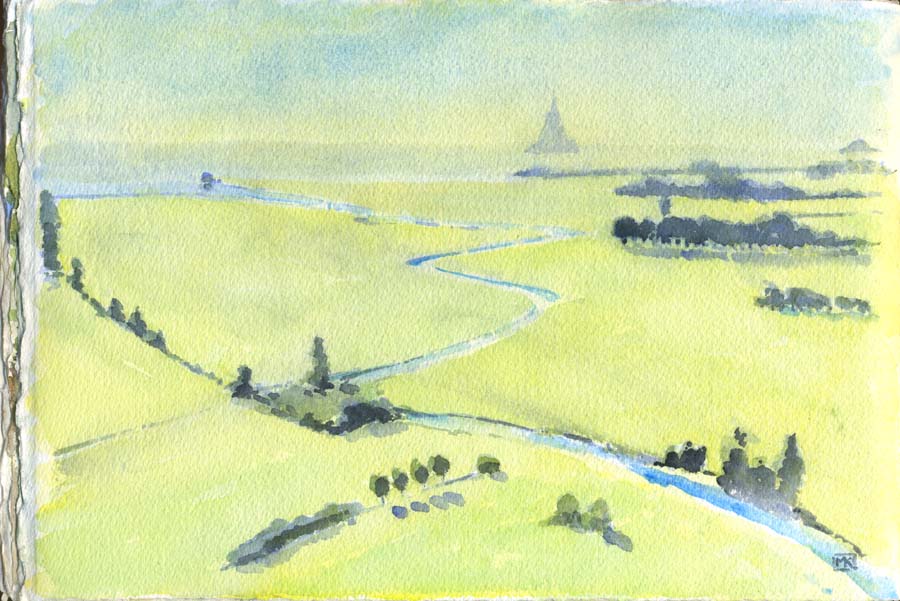
| From the heights of Avranches to the north: the river Sée meanders across flat farmland and drains into the Bay of Mont St. Michel. There is often a misty brûme, and the monastery seems to float in silhouette above the shallow sandy tidal flats known as La Grève. |
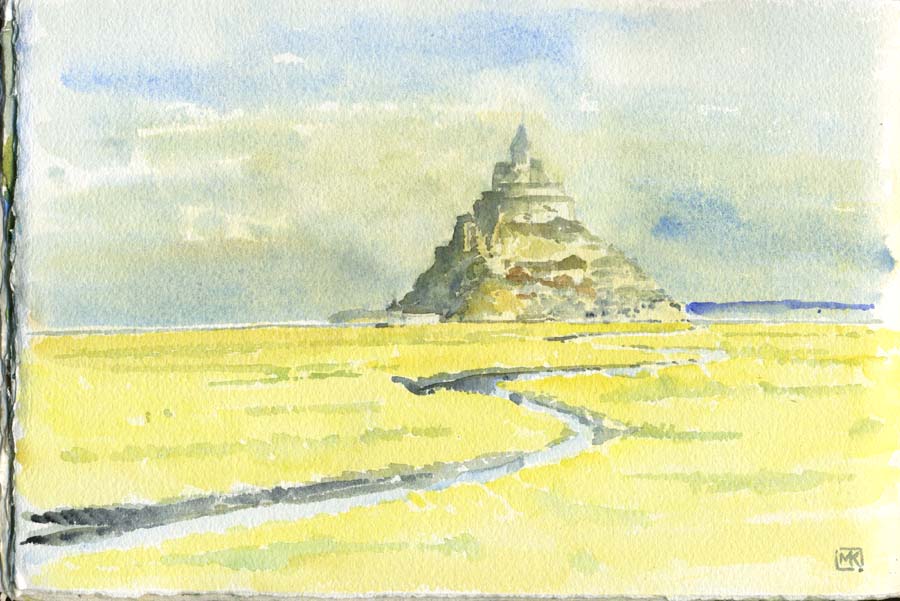
| Access to the Mont is from the south (Avranches, the first of these images, is to the north), where a causeway built 150 years ago runs a couple of kilometres across low farmland and the sand flats. I walked the last kilometre or so and painted (above) alongside another meandering stream which parallels the causeway -- but left the causeway out. Below: along the edge of the causeway, in sight of the three dozen or so tour buses and hundreds of cars visiting for the day, I crouched in the dried mud near the high-tide mark to block in a closer view. |
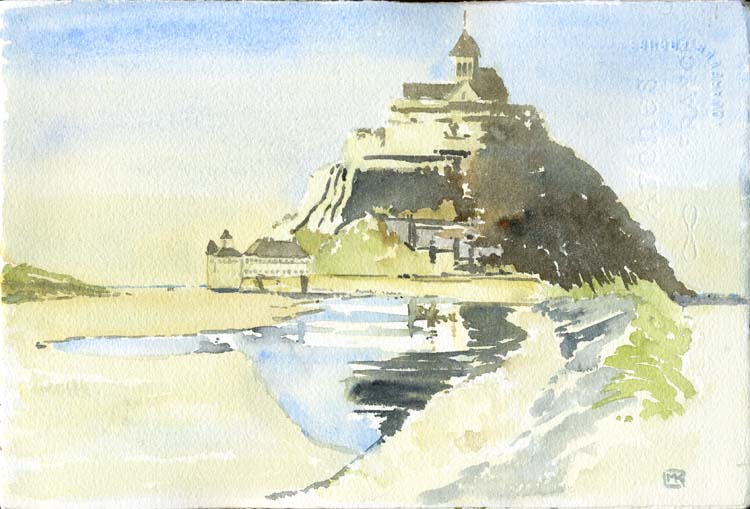
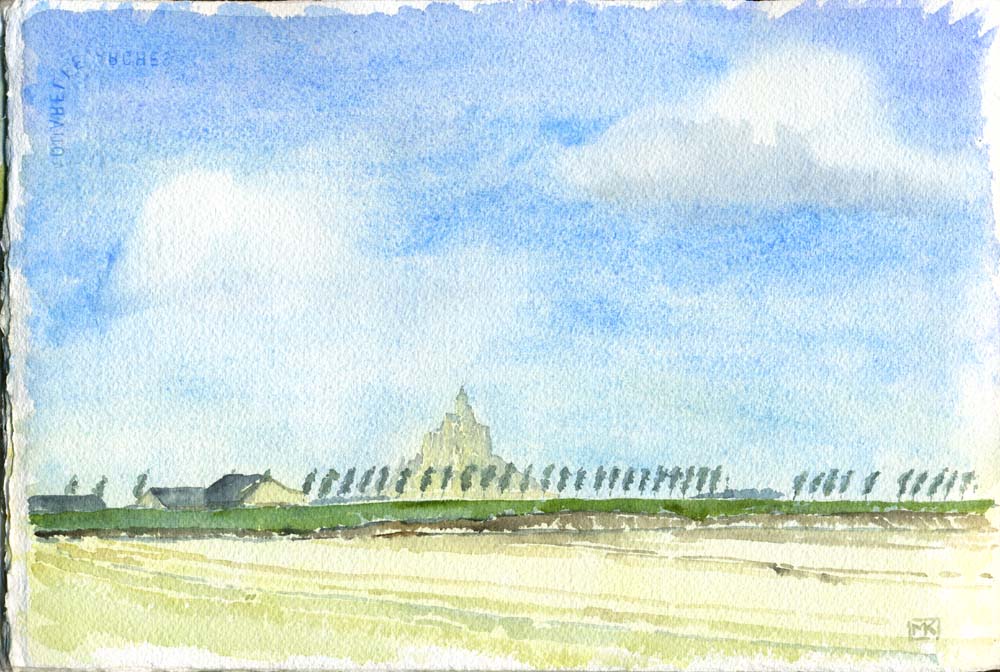
| From the farmland to the south of the bay, as we headed west into Brittany, Mont St. Michel hung pale and distant in the soft maritime air. |
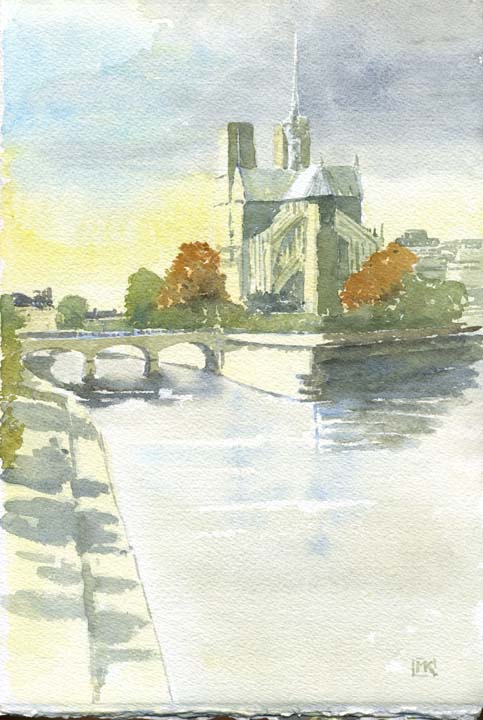 |
 I've been in Paris many
times but had never painted Notre Dame, the view of
which from upstream along the Seine is sublime. On my way to
my preferred viewpoint at the Pont de la Tournelle (left),
I stopped and drew an oil painter labouring away at the Pont
de l'Archeveque (above)
and watched him studiously ignoring the people looking over
his shoulder and seizing his image with their cameras. "There
is an aggression implicit in every use of the camera"--Susan
Sontag.
Below: one of Paris's homeless -- an "SDF" -- Sans Domicile Fixé -- asleep on a bench near the cathedral on a warm autumn afternoon. Is my drawing of this guy as "aggressive" as if I'd taken his photo? Well, every photo of a person is an image of an individual, and is "aggressive" when taken without his permission, whereas a drawing is just a drawing. Or is it? 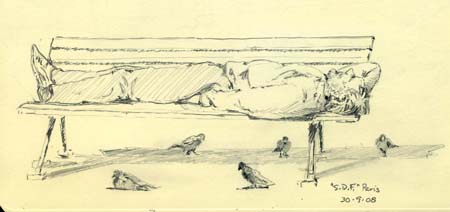 |
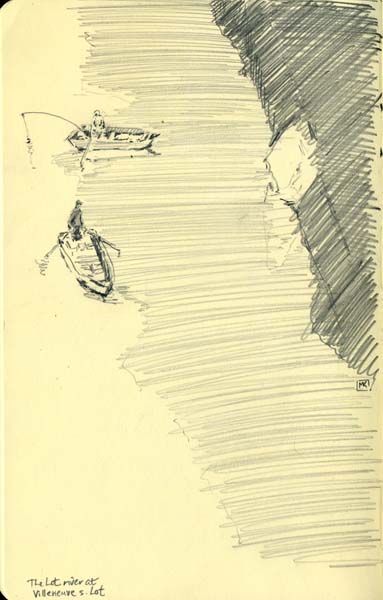 |
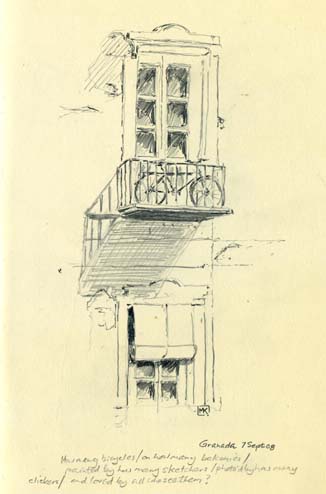 Granada
How many bicycles On how many balconies In how many sketches and snapshots...? |
Return to main travel page Return to home page